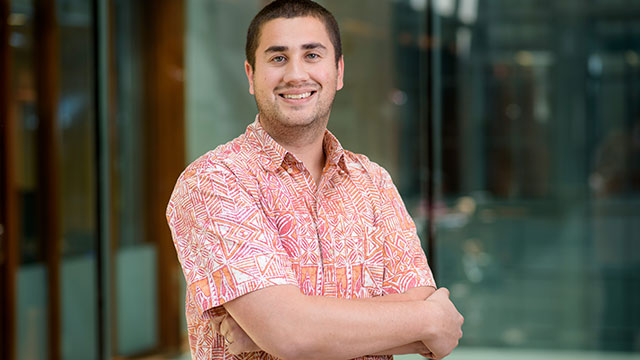When Josiah Hester established his lab at Northwestern in 2018, he couldn’t help but think about the moamoa, the place where a Hawaiian spirit sits to guide ocean-traversing, open-air canoes across the watery frontier. Hester, who is Native Hawaiian, believes that scientists and educators should emulate the spirit in the canoe’s moamoa.
“It is our role to function as a guide for students, colleagues, government and society in general,” said Hester, an assistant professor of computer science in Northwestern’s McCormick School of Engineering. “This is especially crucial as we attempt to tackle global-scale challenges, such as climate change, where often the direction is unknown and the destination far off.”
In celebration of National Native American Heritage Month, Northwestern Now joined Hester for a discussion about the importance of encouraging Native American and Indigenous people in STEM as well as how his cultural background inspired him to develop tools for sustainable computing in his Ka Moamoa lab.
Where did you grow up and where were you before joining Northwestern?
I grew up near the “Research Triangle” in North Carolina because my father worked for the SAS Institute as a computer programmer. But my family is originally from the Big Island in Hawaii and always wanted to get back home. When I was a teenager, we finally moved back. I attended high school in Honolulu, where my parents still live today. Before coming to Northwestern, I completed my Ph.D. at Clemson University.
Who are your Native American or Indigenous heroes in science?
I have several: Isabella Aiona Abbott, Mary G. Ross, Sequoyah and John Bennett Herrington. Abbott was the first native Hawaiian woman to earn a Ph.D. and went on to become a professor of marine botany at Stanford University. Ross worked for NASA during the 1950s and 1960s in the “Golden Age of Space Travel.” She wrote the NASA Planetary Flight Handbook, which outlined plans for traveling to Mars.
It’s sad that we’ve never heard of these people
Unfortunately, that happens to a lot of minority populations, including Native and Indigenous people. They tend to get lost to history. For Native Americans, this problem goes all the way back to the 1400s when Christopher Columbus was given credit for “discovering” North America. Up until current day, it could be because of implicit bias or systemic racism, but our history books don’t talk about the many contributions from people who are minorities. People like Lynn Conway, a transgender woman who quite literally wrote the book on chip design, was fired at IBM when she was outed as transgender. Things that she developed are in every single computer in the world. IBM finally apologized to her 52 years later. It’s tragic because people like Abbott, Ross and Conway show kids that all types of people can pursue and wildly succeed in STEM.
What kind of research do you conduct in your lab?
We are focused on building tiny sustainable computational “things.” This means we build smart electronic devices — such as wearables, sensor networks and other embedded computers — to support numerous global-scale applications across health care, environmental stewardship, infrastructure management and space exploration. For example, we are developing smart face masks that monitor respiration and mask fit, maintenance-free occupancy sensing devices, soil-powered sensors for smart cities and even a battery-free Game Boy. Our research is focused on the underlying computer systems principles, human factors and behavioral issues that arise by bringing this vision to reality. We explore and develop radically new hardware designs, software techniques, tools and programming abstractions, so that developers can easily design, debug and deploy intricate energy-aware applications that work in spite of frequent power failures, constrained resources and unpredictable conditions.
What inspired you to pursue this research?
When I was a baby, my father went to school for computer programming as a way to support the family. He viewed it as a practical skill that could help give our family stability, and my parents pushed me in that direction. But I quickly fell in love with the act of creating and building.
You learn how to automate processes and build things like video games. But you can also use programming to control physical things like robots or sensors. Ultimately, these things can make people’s lives better and easier. After studying programming, I began to see the power and joy in it: The power to help people, and the joy of the experience to create.
After studying programming, I began to see the power and joy in it: The power to help people, and the joy of the experience to create.”
But coupling computer science with sustainability is deeply motivated by my cultural heritage. Sustainability is an issue that Native American and Indigenous people have cared about for thousands of years. For example, Ojibwe people can see the effects of climate change in their crops. They have watched global heating reduce their wild rice crop, year after year, which is a staple food and important cultural product for Ojibwe communities. We can engage technology to address issues that Indigenous people care deeply about, broadening participation in STEM.
Your lab is called the “Ka Moamoa” lab. What does this mean?
The name comes from Hawaiian voyaging traditions, which date back thousands of years. Hawaiians voyaged across the Pacific without navigational instruments, traveling inside open-air canoes and with limited food and water. A small indentation on the extreme back end of the canoe, the moamoa is where the spirit, or akua, sits behind the steersmen to provide guidance on long ocean voyages. Our lab is named after the moamoa as we consider it our role as scientists and educators to function as a guide for students, colleagues, government and society in general, especially when we are attempting to tackle global-scale challenges, such as climate change, where often the direction is unknown and the destination far off.
How can educational institutions, like Northwestern, help encourage Native Americans and Indigenous people to pursue STEM?
We can arm and equip those most ready to do the work, for example, by partnering with the Center for Native American and Indigenous Research here at Northwestern.
The Center for Native American and Indigenous Research is Northwestern’s primary institutional space dedicated to advancing scholarship, teaching, learning and artistic or cultural practices related to Native American and Indigenous communities, priorities, histories and lifeways.
I think a key part here is working under the guidance of the Four R’s of Indigenous Education: Respect, Relevance, Reciprocity and Responsibility. These are values that define any interaction and work with Indigenous folks so that it is not exploitative, is mutually beneficial and will actually make a difference. As a part of this, it’s important to visit Native American and Indigenous people in their own communities to recruit senior high school or community college students. Go out and give a talk or do a demonstration. By going to where they live, they are in a position of inviting you, which means power and autonomy rest with them.
In my own work, I find that sustainability as the application of my science is a key way to both get Indigenous people like myself excited about STEM and to keep that excitement in the long term. Sustainability is something Native and Indigenous people have engaged in long before it had a name; we are in it for the long run, so arming us with tools from STEM helps us continue the work. Once that connection is made, it is a powerful way to work together across Western science and Indigenous knowledge.
How do you define “Native science?”
Native science is any science, exploration and discovery, conducted by Native American and Indigenous folks. Often that work includes a mix of different world views — one rooted in the Western world and one rooted in Indigenous culture, which might include oral histories and traditions.
We can lift Native science by acknowledging that Western knowledge is equal to — not better than — traditional Native knowledge.”
Many Native American and Indigenous people know their land better than anyone else because their families have lived on it for thousands of years. They understand the landscape with an expertise far beyond people with a doctoral education. When you have 1,000 years of oral history and traditional knowledge, that can go toe-to-toe with the Western experts that are at a place like Northwestern.
We can lift Native science by acknowledging that Western knowledge is equal to — not better than — traditional Native knowledge. Then, we can find ways for these areas to collaborate and learn from each other. At Northwestern, for example, we have many faculty members deeply interested in sustainability. We can find ways for Northwestern researchers to engage with Indigenous experts to solve problems together. That would be really powerful, and we already see this happening in places like the Center for Engineering Sustainability and Resilience and the Institute for Sustainability and Energy at Northwestern.
How are you supporting the next generation of Native American and Indigenous scholars?
CNAIR is making a campus walking path about Northwestern’s Native American history. I’m helping them make interactive, sustainable, ecologically friendly displays along the path. I’m also training an Indigenous student to help with the electronic platform and envision other ways interactive technology can better tell stories of Indigenous people.
We are also building digital observation toolkits so that Native and Indigenous youth can take a phone and low-cost sensors to conduct scientific experiments and observations on tribal lands. This is as simple as snapping a picture of an endangered species on the land or recording water levels and temperature of the wild rice beds.
We are lately working with Pūʻōhala Elementary School in Hawaii on programming sustainable smart devices that can conduct environmental measurements. This enables the students to safeguard their home and monitor the changes brought by climate change. We hope to build curriculum and pedagogy that can be broadly applied to further train and engage Indigenous students.
Overall these efforts are trying to meet Indigenous and Native people where they are, equip them with tools they appreciate and can use, and that will provide continuous engagement and opportunities in STEM from elementary school to post-graduate.


